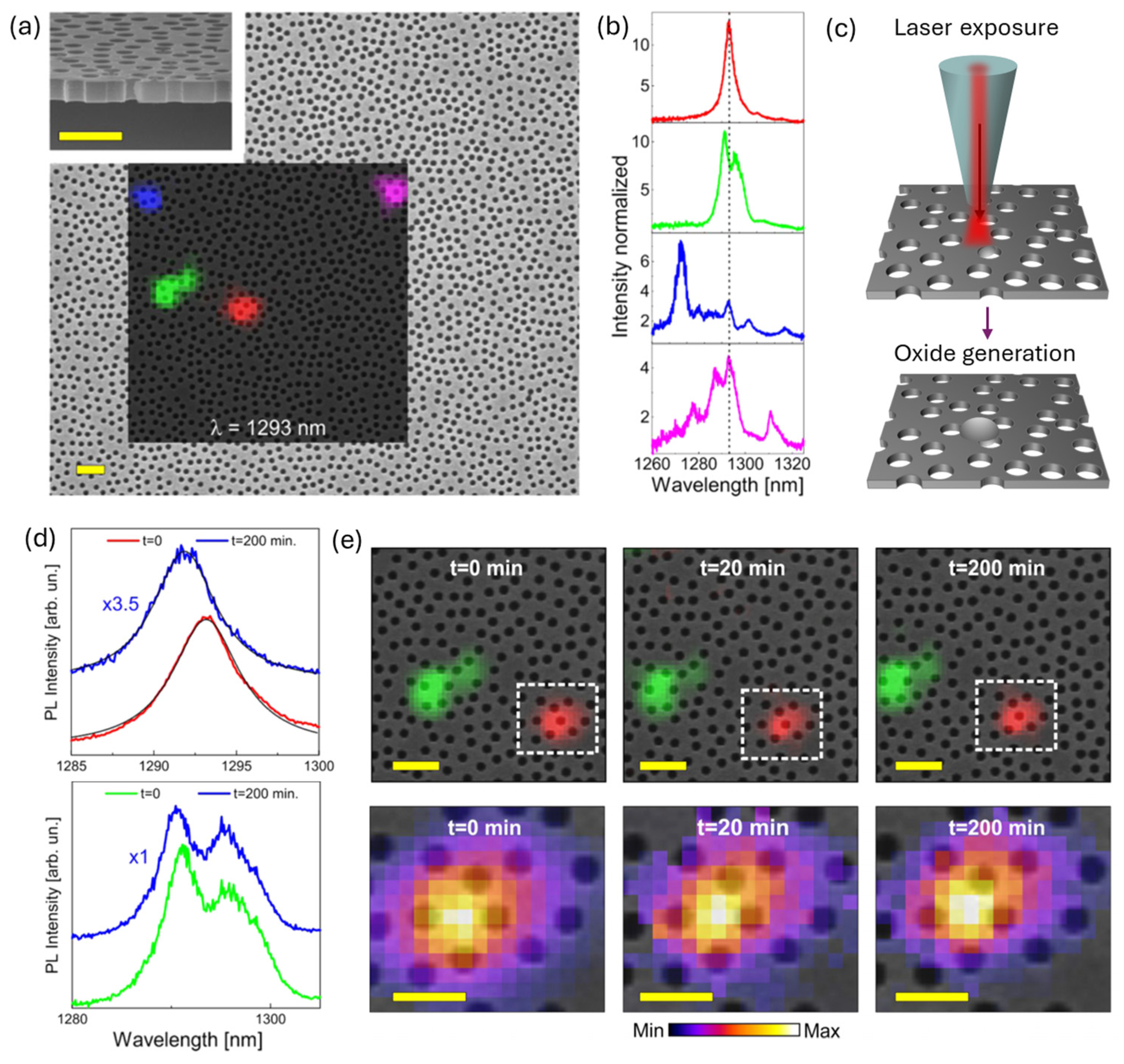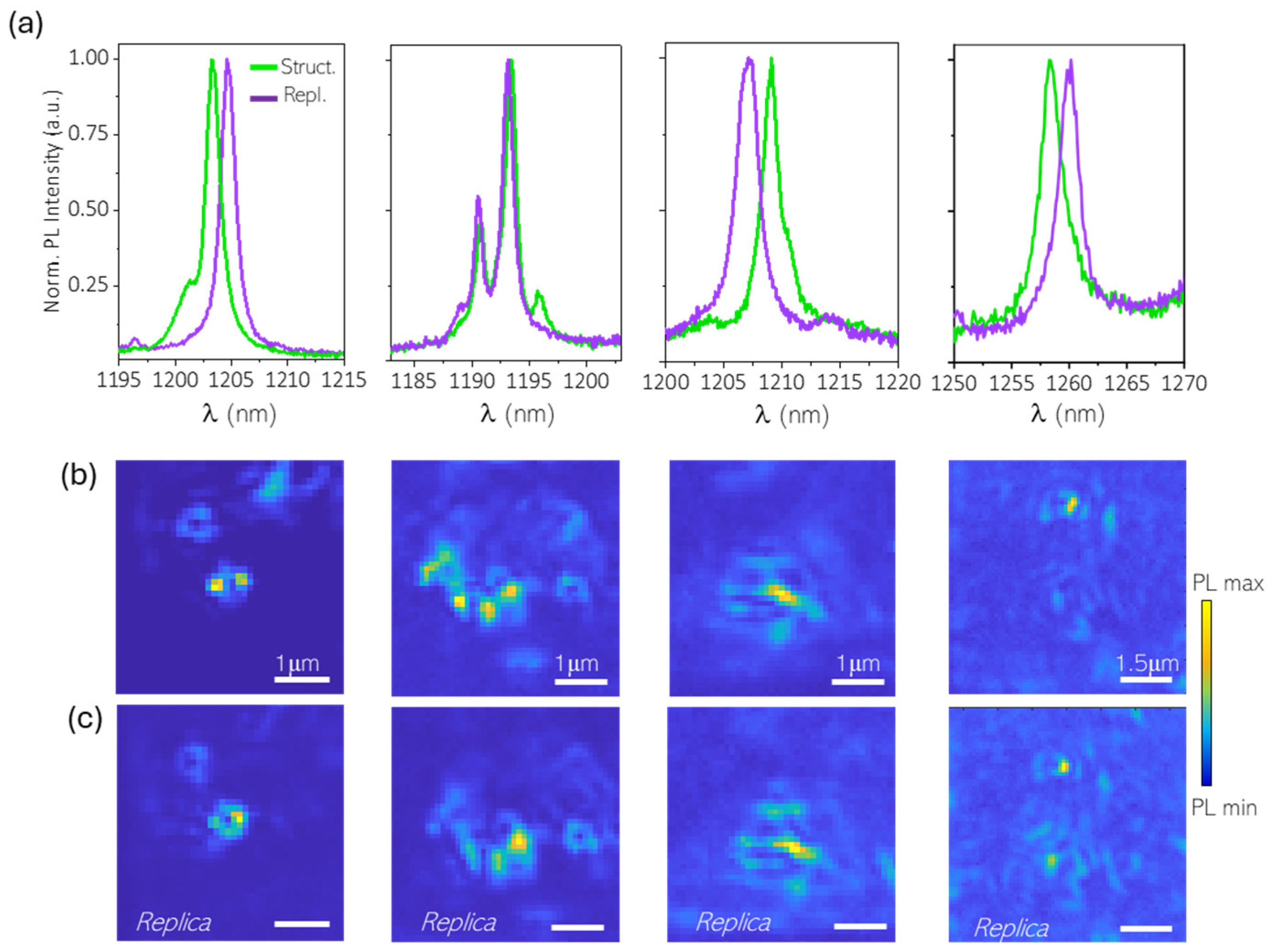Scanning Near-Field Optical Microscopy: Recent Advances in Disordered and Correlated Disordered Photonics
Abstract
:1. Introduction
2. Scanning Near-Field Optical Microscopy
3. Near-Field Optical Microscopy of Disordered Photonic Structures
3.1. Engineering of Light Confinement in Random Dielectrics
3.2. Nanoscale Mechanical Actuation with SNOM Tip on Random Modes
4. Light Transport Regimes and Localization in Hyperuniform Disordered Photonic Systems
5. Conclusions
Funding
Institutional Review Board Statement
Informed Consent Statement
Data Availability Statement
Acknowledgments
Conflicts of Interest
References
- Sheng, P. Introduction to Wave Scattering. In Localization and Mesoscopic Phenomena, 2nd ed.; Academic: San Diego, CA, USA, 2000. [Google Scholar]
- Riboli, F.; Uccheddu, F.; Monaco, G.; Caselli, N.; Intonti, F.; Gurioli, M.; Skipetrov, S.E. Tailoring Correlations of the Local Density of States in Disordered Photonic Materials. Phys. Rev. Lett. 2017, 119, 043902. [Google Scholar] [CrossRef] [PubMed]
- Anderson, P.W. Absence of Diffusion in Certain Random Lattices. Phys. Rev. 1958, 109, 1492–1505. [Google Scholar] [CrossRef]
- Wiersma, D.; Bartolini, P.; Lagendijk, A.; Righini, R. Localization of light in a disordered medium. Nature 1997, 390, 671–673. [Google Scholar] [CrossRef]
- Balestri, D.; Petruzzella, M.; Checcucci, S.; Intonti, F.; Caselli, N.; Sgrignuoli, F.; van Otten, F.W.M.; Fiore, A.; Gurioli, M. Mechanical and Electric Control of Photonic Modes in Random Dielectrics. Adv. Mater. 2019, 31, 1807274. [Google Scholar] [CrossRef] [PubMed]
- Mafi, A.; Karbasi, S.; Koch, K.W.; Hawkins, T.; Ballato, J. Transverse Anderson Localization in Disordered Glass Optical Fibers: A Review. Materials 2014, 7, 5520–5527. [Google Scholar] [CrossRef] [PubMed]
- Froufe-Pérez, L.S.; Engel, M.; Sáenz, J.J.; Scheffold, F. Band gap formation and Anderson localization in disordered photonic materials with structural correlations. Proc. Natl. Acad. Sci. USA 2017, 114, 9570–9574. [Google Scholar] [CrossRef] [PubMed]
- Sapienza, L.; Thyrrestrup, H.; Stobbe, S.; Garcia, P.D.; Smolka, S.; Lodahl, P. Cavity quantum electrodynamics with Anderson localized modes. Science 2010, 327, 1352. [Google Scholar] [CrossRef] [PubMed]
- Riboli, F.; Caselli, N.; Vignolini, S.; Intonti, F.; Vynck, K.; Barthelemy, V.M.P.; Gerardino, A.; Balet, L.P.; Li, L.H.; Fiore, A.; et al. Engineering of light confinement in strongly scattering disordered media. Nat. Mater. 2014, 13, 720–725. [Google Scholar] [CrossRef] [PubMed]
- Caselli, N.; Riboli, F.; Intonti, F.; La China, F.; Biccari, F.; Gerardino, A.; Gurioli, M. Spatial steadiness of individual disorder modes upon controlled spectral tuning. APL Photonics 2016, 1, 041301. [Google Scholar] [CrossRef]
- Torquato, S.; Stillinger, F.H. Local density fluctuations, hyperuniformity, and order metrics. Phys. Rev. E 2003, 68, 041113. [Google Scholar] [CrossRef]
- Redding, B.; Liew, S.; Sarma, R.; Cao, H. Compact spectrometer based on a disordered photonic chip. Nat. Photonics 2013, 7, 746–751. [Google Scholar] [CrossRef]
- Ching, E.; Leung, P.; Maassen van den Brink, A.; Suen, W.; Tong, S.; Young, K. Quasinormal-mode expansion for waves in open systems. Rev. Mod. Phys. 1998, 70, 1545–1554. [Google Scholar] [CrossRef]
- Noginov, M.; Dewar, G.; McCall, M.; Zheludev, N. Tutorials in Complex Photonic Media; SPIE: Bellingham, WA, USA, 2010; Chapter 9. [Google Scholar]
- Popoff, S.; Lerosey, G.; Carminati, R.; Fink, M.; Boccara, A.; Gigan, S. Measuring the Transmission Matrix in Optics: An Approach to the Study and Control of Light Propagation in Disordered Media. Phys. Rev. Lett. 2010, 104, 0601. [Google Scholar] [CrossRef] [PubMed]
- Labonté, L.; Vanneste, C.; Sebbah, P. Localized mode hybridization by fine tuning of two-dimensional random media. Opt. Lett. 2012, 37, 1946–1948. [Google Scholar] [CrossRef]
- Vanneste, C.; Sebbah, P. Complexity of two-dimensional quasimodes at the transition from weak scattering to Anderson localization. Phys. Rev. A 2009, 79, 1802. [Google Scholar] [CrossRef]
- Intonti, F.; Caselli, N.; Vignolini, S.; Riboli, F.; Kumar, S.; Rastelli, A.; Schmidt, O.G.; Francardi, M.; Gerardino, A.; Balet, L.; et al. Mode tuning of photonic crystal nanocavities by photoinduced non-thermal oxidation. Appl. Phys. Lett. 2012, 100, 033116. [Google Scholar] [CrossRef]
- Krause, A.G.; Winger, M.; Blasius, T.D.; Lin, Q.; Painter, O. A high-resolution microchip optomechanical accelerometer. Nat. Photonics 2012, 6, 768. [Google Scholar] [CrossRef]
- Liu, F.; Alaie, S.; Leseman, Z.C.; Hossein-Zadeh, M. Sub-pg mass sensing and measurement with an optomechanical oscillator. Opt. Express 2013, 21, 19555. [Google Scholar] [CrossRef] [PubMed]
- Faraon, A.; Vučković, J. Local temperature control of photonic crystal devices via micron-scale electrical heaters. Appl. Phys. Lett. 2009, 95, 043102. [Google Scholar] [CrossRef]
- Intonti, F.; Vignolini, S.; Riboli, F.; Zani, M.; Wiersma, D.S.; Balet, L.; Li, L.H.; Francardi, M.; Gerardino, A.; Fiore, A.; et al. Tuning of photonic crystal cavities by controlled removal of locally infiltrated water. Appl. Phys. Lett. 2009, 95, 173112. [Google Scholar]
- Suh, W.; Yanik, M.F.; Solgaard, O.; Fan, S. Displacement-sensitive photonic crystal structures based on guided resonance in photonic crystal slabs. Appl. Phys. Lett. 2003, 82, 1999. [Google Scholar] [CrossRef]
- Midolo, L.; van Veldhoven, P.J.; Dundar, M.A.; Notzel, R.; Fiore, A. Electromechanical wavelength tuning of double-membrane photonic crystal cavities. Appl. Phys. Lett. 2011, 98, 211120. [Google Scholar] [CrossRef]
- Granchi, N.; Petruzzella, M.; Balestri, D.; Fiore, A.; Gurioli, M.; Intonti, F. Multimode photonic molecules for advanced force sensing. Opt. Express 2019, 27, 37579–37589. [Google Scholar] [CrossRef] [PubMed]
- Petruzzella, M.; La China, F.; Intonti, F.; Caselli, N.; De Pas, M.; van Otten, F.W.M.; Gurioli, M.; Fiore, A. Nanoscale mechanical actuation and near-field read-out of photonic crystal molecules. Phys. Rev. B 2016, 94, 115413. [Google Scholar] [CrossRef]
- Haus, H.A.; Huang, W.P.; Kawakami, S.; Whitaker, N.A. Coupled-mode theory of optical waveguides. J. Light. Technol. 1987, 5, 16. [Google Scholar] [CrossRef]
- Midolo, L.; Pagliano, F.; Hoang, T.B.; Xia, T.; van Otten, F.W.M.; Li, L.H.; Linfield, E.H.; Lermer, M.; Hofling, S.; Fiore, A. Spontaneous emission control of single quantum dots by electromechanical tuning of a photonic crystal cavity. Appl. Phys. Lett. 2012, 101, 091106. [Google Scholar] [CrossRef]
- Koenderink, A.F.; Kafesaki, M.; Buchler, B.C.; Sandoghdar, V. Controlling the Resonance of a Photonic Crystal Microcavity by a Near-Field Probe. Phys. Rev. Lett. 2005, 95, 153904. [Google Scholar] [CrossRef]
- Intonti, F.; Vignolini, S.; Riboli, F.; Vinattieri, A.; Wiersma, D.S.; Colocci, M.; Balet, L.; Monat, C.; Zinoni, C.; Li, L.H.; et al. Spectral tuning and near-field imaging of photonic crystal microcavities. Phys. Rev. B 2008, 78, 041401(R). [Google Scholar] [CrossRef]
- Louvion, N.; Gérard, D.; Mouette, J.; de Fornel, F.; Seassal, C.; Letartre, X.; Rahmani, A.; Callard, S. Local Observation and Spectroscopy of Optical Modes in an Active Photonic-Crystal Microcavity. Phys. Rev. Lett. 2005, 94, 113907. [Google Scholar] [CrossRef]
- Kramper, P.; Kafesaki, M.; Soukoulis, C.M.; Birner, A.; Müller, F.; Gösele, U.; Wehrspohn, R.B.; Mlynek, J.; Sandoghdar, V. Near-field visualization of light confinement in a photonic crystal microresonator. Opt. Lett. 2004, 29, 174. [Google Scholar] [CrossRef]
- Volkov, V.S.; Bozhevolnyi, S.I.; Borel, P.I.; Frandsen, L.H.; Kristensen, M. Near-field characterization of low-loss photonic crystal waveguides. Phys. Rev. B 2005, 72, 035118. [Google Scholar] [CrossRef]
- Vynck, K.; Pierrat, R.; Carminati, R.; Froufe-Pérez, L.S.; Scheffold, F.; Sapienza, R.; Vignolini, S.; Sáenz, J.J. Light in correlated disordered media. Rev. Mod. Phys. 2023, 95, 045003. [Google Scholar] [CrossRef]
- Florescu, M.; Torquato, S.; Steinhardt, P.J. Designer disordered materials with large, complete photonic band gaps. Proc. Natl. Acad. Sci. USA 2009, 106, 20658–20663. [Google Scholar] [CrossRef] [PubMed]
- Leseur, O.; Pierrat, R.; Carminati, R. High-density hyperuniform materials can be transparent. Optica 2016, 3, 763–767. [Google Scholar] [CrossRef]
- Muller, N.; Haberko, J.; Marichy, C.; Scheffold, F. Silicon hyperuniform disordered photonic materials with a pronounced gap in the shortwave infrared. Adv. Opt. Mater. 2014, 2, 115–119. [Google Scholar] [CrossRef]
- Castro-Lopez, M.; Gaio, M.; Sellers, S.; Gkantzounis, G.; Florescu, M.; Sapienza, R. Reciprocal space engineering with hyperuniform gold disordered surfaces. APL Photonics 2017, 2, 061302. [Google Scholar] [CrossRef]
- Aubry, G.J.; Froufe-Pérez, L.S.; Kuhl, U.; Legrand, O.; Scheffold, F.; Mortessagne, F. Experimental Tuning of Transport Regimes in Hyperuniform Disordered Photonic Materials. Phys. Rev. Lett. 2020, 125, 127402. [Google Scholar] [CrossRef] [PubMed]
- Razo-López, L.A.; Aubry, G.J.; Pinheiro, F.A.; Mortessagne, F. Strong localization of microwaves beyond two dimensions in aperiodic Vogel spirals. Phys. Rev. B 2024, 109, 014205. [Google Scholar] [CrossRef]
- Granchi, N.; Spalding, R.; Lodde, M.; Petruzzella, M.; Otten, F.W.; Fiore, A.; Intonti, F.; Sapienza, R.; Florescu, M.; Gurioli, M. Near-Field Investigation of Luminescent Hyperuniform Disordered Materials. Adv. Opt. Mater. 2022, 10, 2102565. [Google Scholar] [CrossRef]
- Granchi, N.; Lodde, M.; Stokkereit, K.; Spalding, R.; van Veldhoven, P.J.; Sapienza, R.; Fiore, A.; Gurioli, M.; Florescu, M.; Intonti, F. Near-field imaging of optical nanocavities in hyperuniform disordered materials. Phys. Rev. B 2023, 107, 06420. [Google Scholar] [CrossRef]
- Granchi, N.; Spalding, R.; Stokkereit, K.; Lodde, M.; Petruzzella, M.; Otten, F.V.; Sapienza, R.; Fiore, A.; Florescu, M.; Intonti, F. High spatial resolution imaging of light localization in hyperuniform disordered patterns of circular air pores in a dielectric slab. Front. Photonics 2023, 4, 1199411. [Google Scholar] [CrossRef]
- Imagawa, S.; Edagawa, K.; Morita, K.; Niino, T.; Kagawa, Y.; Notomi, M. Photonic band-gap formation, light diffusion, and localization in photonic amorphous diamond structures. Phys. Rev. B 2010, 82, 115116. [Google Scholar] [CrossRef]
- Yuan, T.; Feng, T.; Xu, T. Manipulation of transmission by engineered disorder in one-dimensional photonic crystals. Opt. Express 2019, 27, 6483–6494. [Google Scholar] [CrossRef] [PubMed]
- Milosevic, M.M.; Man, W.; Nahal, G.; Steinhardt, P.J.; Torquato, S.; Chaikin, P.M.; Amoah, T.; Yu, B.; Mullen, R.A.; Florescu, M. Hyperuniform disordered waveguides and devices for near infrared silicon photonics. Sci. Rep. 2019, 9, 20338. [Google Scholar] [CrossRef] [PubMed]
- Florescu, M.; Steinhardt, P.J.; Torquato, S. Optical cavities and waveguides in hyperuniform disordered photonic solids. Phys. Rev. B 2013, 87, 165116. [Google Scholar] [CrossRef]
- Amoah, T.; Florescu, M. High-Q optical cavities in hyperuniform disordered materials. Phys. Rev. B 2015, 91, 020201(R). [Google Scholar] [CrossRef]
- Chan, Y.S.; Chan, C.T.; Liu, Z.Y. Photonic Band Gaps in Two Dimensional Photonic Quasicrystals. Phys. Rev. Lett. 1998, 80, 956. [Google Scholar] [CrossRef]





Disclaimer/Publisher’s Note: The statements, opinions and data contained in all publications are solely those of the individual author(s) and contributor(s) and not of MDPI and/or the editor(s). MDPI and/or the editor(s) disclaim responsibility for any injury to people or property resulting from any ideas, methods, instructions or products referred to in the content. |
© 2024 by the author. Licensee MDPI, Basel, Switzerland. This article is an open access article distributed under the terms and conditions of the Creative Commons Attribution (CC BY) license (https://creativecommons.org/licenses/by/4.0/).
Share and Cite
Granchi, N. Scanning Near-Field Optical Microscopy: Recent Advances in Disordered and Correlated Disordered Photonics. Photonics 2024, 11, 734. https://doi.org/10.3390/photonics11080734
Granchi N. Scanning Near-Field Optical Microscopy: Recent Advances in Disordered and Correlated Disordered Photonics. Photonics. 2024; 11(8):734. https://doi.org/10.3390/photonics11080734
Chicago/Turabian StyleGranchi, Nicoletta. 2024. "Scanning Near-Field Optical Microscopy: Recent Advances in Disordered and Correlated Disordered Photonics" Photonics 11, no. 8: 734. https://doi.org/10.3390/photonics11080734




